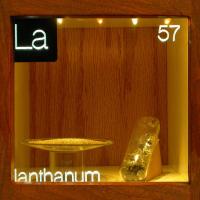Home Size: 1 2 3 4 5 6 7 8 9
|
 |
| A fairly soft silvery metal that is the first of the lanthanide rare earths. It is reactive and quickly turns to a white powder if exposed to the air.
|
|
|
 |
Lumps ampouled under argon.
Lanthanum is the first of the rare earths and it gives its name to the more appropriate name for these 14 closely related elements: the lanthanides. Superficially they mainly have very similar physical and chemical properties, although as you get to know them, their subtle individual characteristics become apparent. Lanthanum itself is one of the softer metals and can be easily divided with stout cutters as we have done here to fit the lumps into a glass tube for ampouling under argon. When freshly cut, lanthanum metal is bright silver. But even with traces of oxygen left in the vessel, it quickly yellows and darkens.
Source: China
Size: 0.75"
Purity: 99.5%
|
|
 |
Monazite sand.
This is the main phosphate ore from which all the lanthanides are obtained, although increasingly production is moving over the to main alternative - bastnasite - which is free of the radioactive element thorium. Sands like this can be found on a number of beaches around the world, notably in India and Brazil. The monazite itself are the darker grains with a reddish tinge. These are relatively heavy (which is why they are concentrated in sands) and they can be separated by gravity methods. Because of the thorium contained in the monazite, such beaches are not very healthy places to be. Background radiation levels are well above the safety thresholds in nuclear reactor buildings!
Source: eBay
Size: Coarse sand
Purity: La up to 20%
|
|
|

